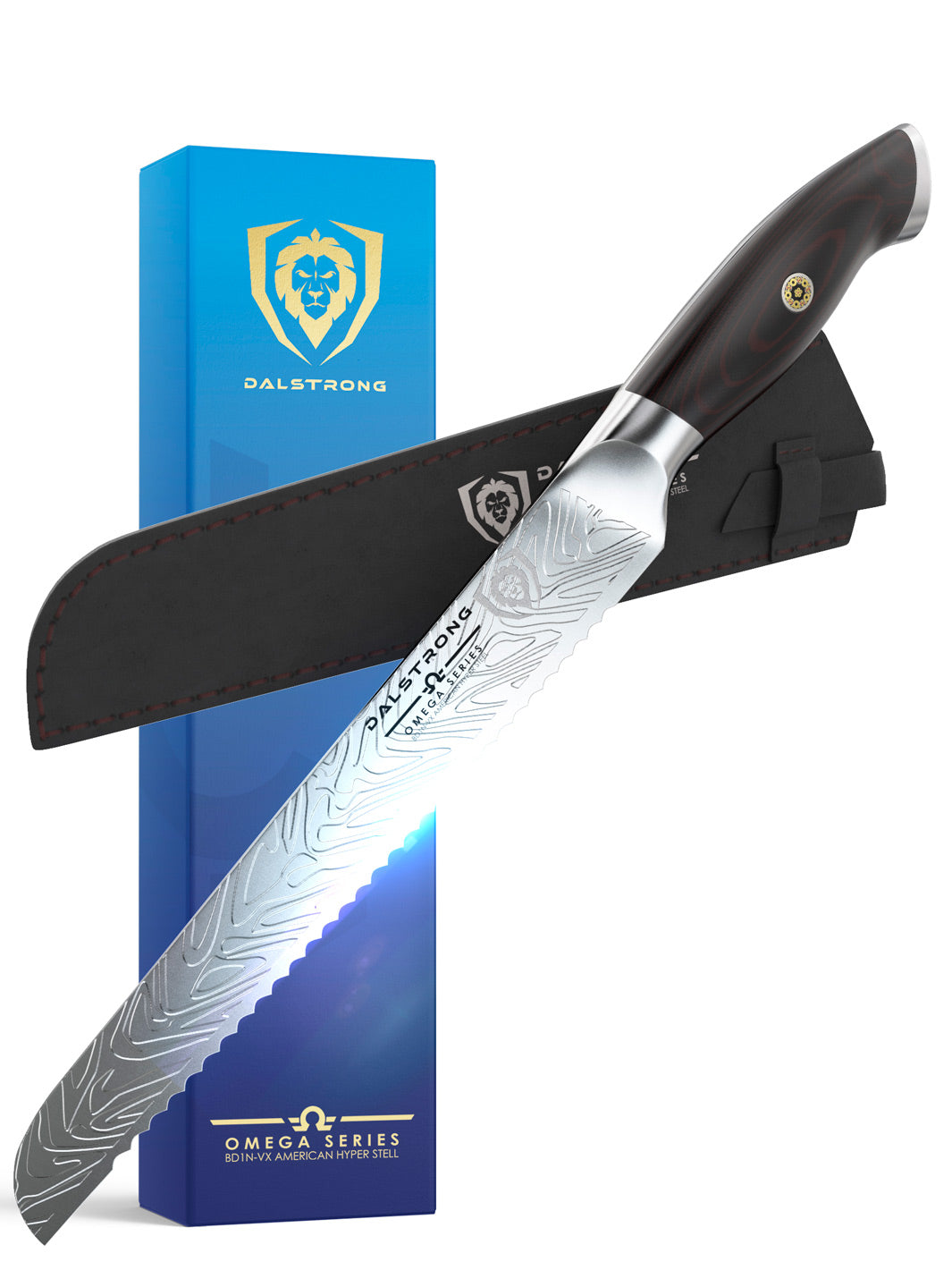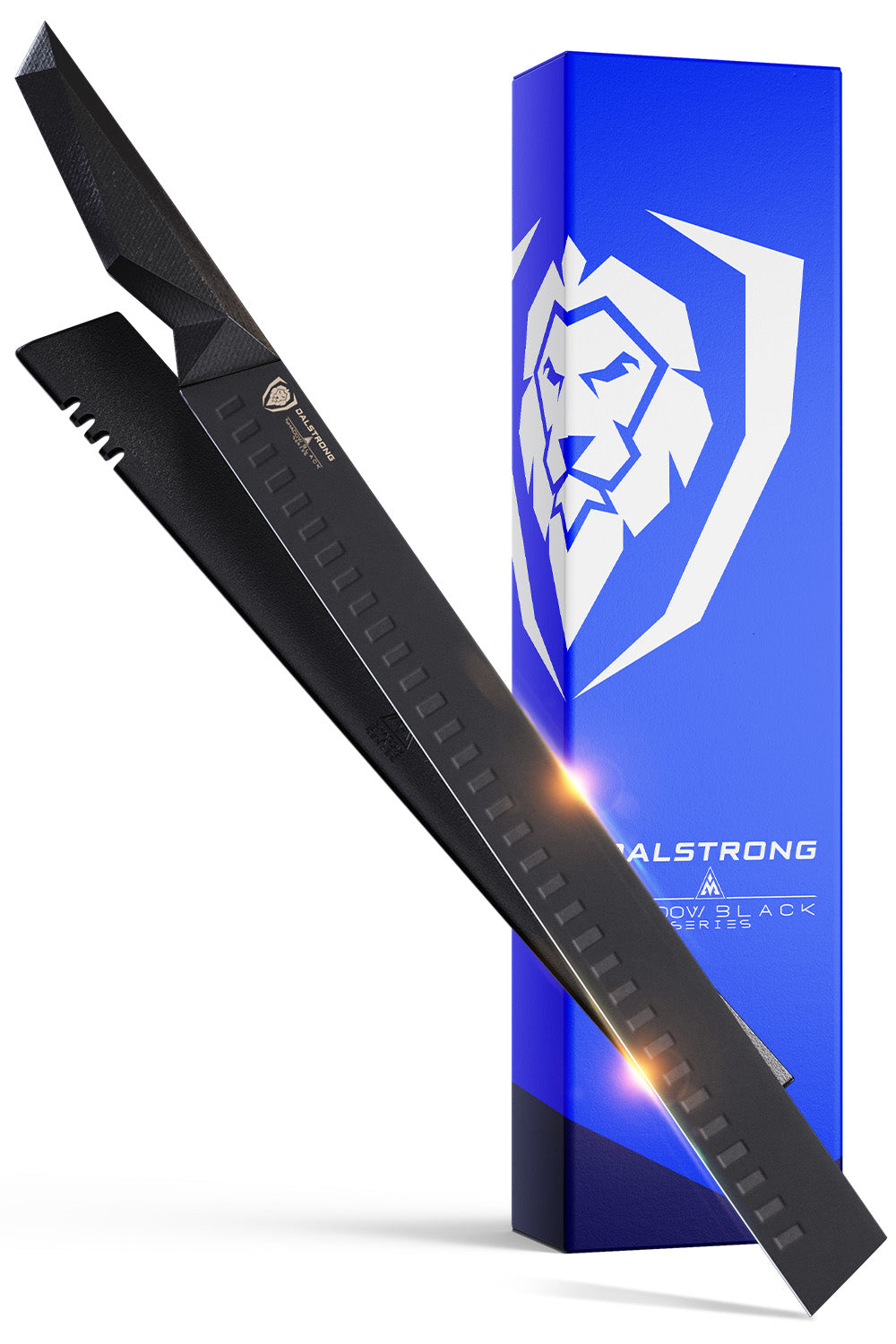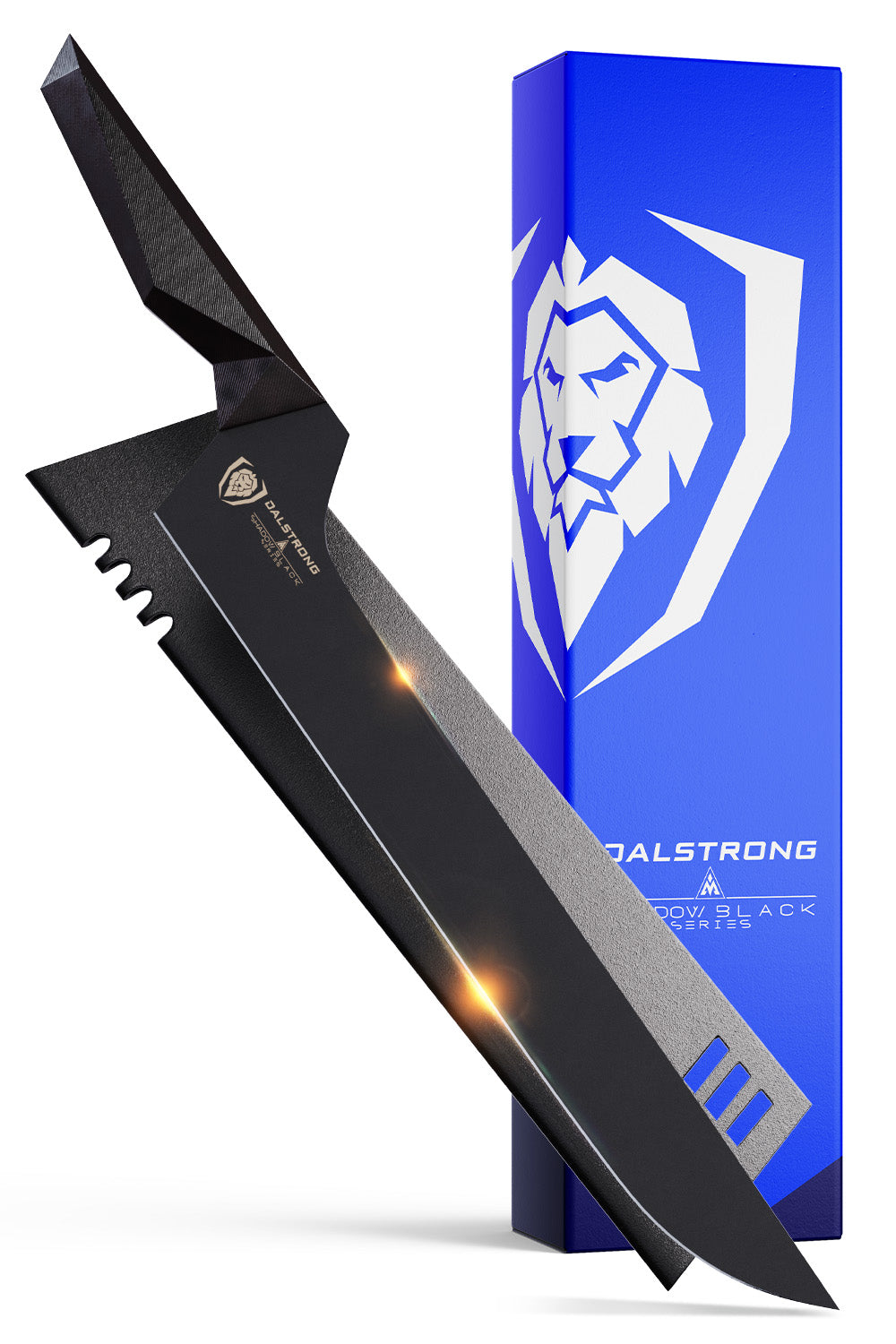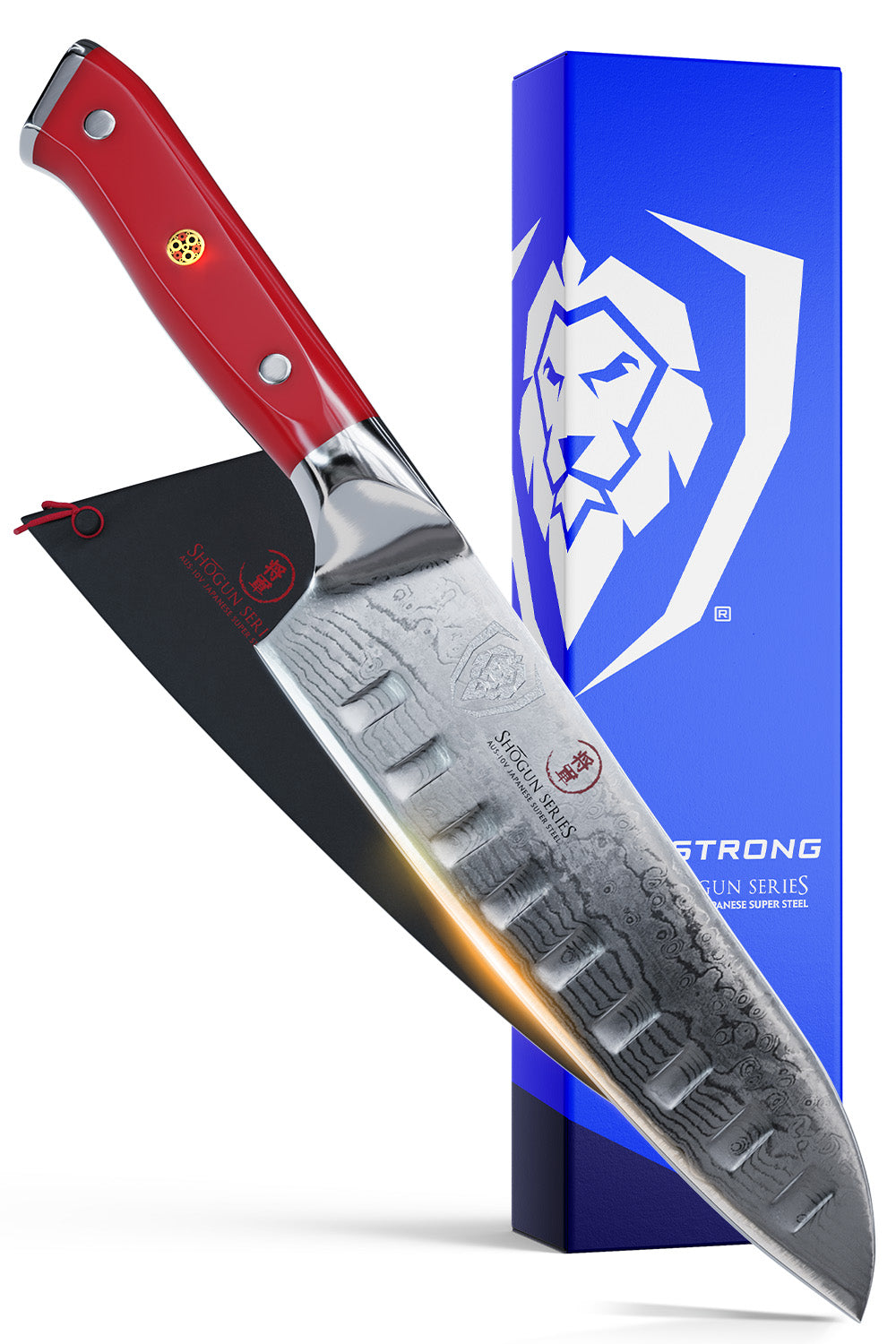Gladiator Series 8" Slicing & Carving Knife
Quick Steps Overview: How To Cook Pork Tenderloin
- Set up the cooking station
- Prep the oven and tenderloin
- Mix dry ingredients in a bowl
- Add pork to a frying pan
- Move pork to a baking dish
- Return pan to heat and add beef broth
- Add apple cider vinegar and butter
- Bake the pork
- Rest, slice and serve
Coated in a spice rub, browned in a pan, and baked to perfection, classic pork tenderloins have become my preferred go-to dinners. It is affordable, quick to cook, tastes great, and will give you melt-in-your-mouth tender pork slices- making it perfect for a dinner party or Sunday lunch with the family.
However, it can take you a while before finally figuring out how to cook a juicy, flavorful pork tenderloin. Without the correct technique, you can easily end up with dried-out, bland pork. Today I will be walking you through the process of cooking the perfect pork tenderloin in the oven. With this step-by-step guide, you will never have to sit through a dinner of flavorless pork tenderloin ever again.
 Dalstrong Professional Chef's Kitchen Apron - Sous Team 6"
Dalstrong Professional Chef's Kitchen Apron - Sous Team 6"
1. Difference: Pork Loin VS Pork Tenderloin
Before we get into the details of the pork tenderloin recipe and cooking method, let me quickly point out some of the major differences between pork loin and pork tenderloin. Firstly, both of them are two different cuts of meat that need to be cooked differently.
|
Pork Tenderloin |
Pork Loin |
|
This comes from a muscle that runs along with the spine. |
This is often referred to as the rib roast and comes from the rib section. |
|
It is not a well-used muscle, so it is very tender. It is long, thin, and very lean. |
It is tougher and can be bone-in or boneless. It is often sold with a thick fat-cap on it. |
|
It is a smaller cut and usually weighs around 1 pound. |
It is a large cut of meat and is generally sold as a 3-5 pound roast. |
2. 7 Methods for Cooking Pork Tenderloin
A well-sized pork tenderloin typically feeds a family of four and is very lean. And because of this, this cut of meat stands a chance to run dry very fast. The important thing to remember when it comes to this popular cut is the fact that there are multiple ways you can cook this type of meat.
Let’s take a look at some of the most popular methods:
1. Slow Cooker Method
While this method is super easy and convenient, it takes about 4 hours to finish and you might not always get the desired final product. With this method, you run the risk of the meat turning pale and grey and the texture, dry. At times, you might even notice that all of the rich pork flavors would have leaked out into the cooking liquid.
2. Instant Pot Method
This quick method takes about 25 minutes to cook the meat. You can expect the tenderloin to be very juicy inside, with a nice pink color. While this method takes very little time, the meat can be slightly chewy and the flavor can seem a bit watered-down and diluted.
3. Air Fryer
With an air fryer, you will take about 27 minutes to cook the tenderloin. The result of this will be a beautiful golden crust on the outside. The insides however can seem to lack the juiciness of some of the others methods listed below.
4. Sous Vide
This method requires you to place the meat in a zip-lock bag and lower the pack into water circulating at 140 degrees F. The method has also proved to be pretty effective in cooking the meat well. The result of this was pork that let out almost no juices onto the platter when sliced, suggesting that all the juices stayed inside. While this helps make the meat incredibly juicy and moist, it can get a little too tender which might not be preferred by everyone.
5. Oven-Roasted
This is one of my most trusted methods when it comes to cooking tenderloin. In about 30 minutes, you can achieve a perfectly cooked piece of meat. When using this method, you will notice that when resting, the tenderloin lets out lots of juices. Resting the meat gives it time to absorb the juice back and gives you an interior that has a lovely pink color and is very juicy. Make sure not to overcook the meat or you might end up with bites that are too chewy.
6. Grilled
In 30 to 35 minutes you will be able to achieve an extremely juicy and moist piece of pork tenderloin. This also lends the meat a robust grilled flavor and a beautifully done crust. You must keep a check on the meat using a meat thermometer as you might run the risk of making the meat slightly tougher than what it is supposed to be.
7. Slow Roasted
To be honest, this method is a sure-shot winner for me. While it took almost an hour to get the meat done, it also proved to yield both juicy and very tender slices of meat. This method tends to dry out the pork in the oven in a way that its porky-rich flavor is intact and allows for a hearty crust to form when seared. The low cooking temperature cooks the meat evenly, making sure you don't overcook it.
3. Baked Pork Tenderloin Recipe
|
Baked Pork Tenderloin |
|||
|
Prep Time 10 mins |
Cook Time 20 mins |
Total Time 30 mins |
Servings 6 |
|
Ingredients |
|
|
Pork Tenderloin |
|
|
Spice Rub |
|
|
Cooking Instructions |
|
|
Step 1: Set up the cooking station |
|
|
Step 2: Prep the oven and tenderloin |
|
|
Step 3: Mix dry ingredients in a bowl |
|
|
Step 4: Add pork to a frying pan |
|
|
Step 5: Move pork to a baking dish |
|
|
Step 6: Return the pan to heat and add beef broth |
|
|
Step 7: Add apple cider vinegar and butter |
|
|
Step 8: Bake the pork |
|
|
Step 9: Rest, slice and serve |
|
4. Alternate Recipe: Oven-Roasted Pork Tenderloin
|
Oven-Roasted Pork Tenderloin |
||||
|
Prep Time 10 mins |
Marination Time 30 mins |
Cook Time 20 mins |
Total Time 1-hour |
Servings 4 |
|
Ingredients |
|
|
Pork Tenderloin |
|
|
Ingredients |
|
|
Balsamic & Rosemary Marinade |
|
|
Cooking Instructions |
|
|
Step 1: Prepare the marinade |
|
|
Step 2: Trim and season |
|
|
Step 3: Pour the marinade |
|
|
Step 4: Preheat the oven |
|
|
Step 5: Place the pork in the pan |
|
|
Step 6: Brush with marinade |
|
|
Step 7: Transfer to the over |
|
|
Step 8: Rest, slice and serve |
|
5. Tips to Cook Pork Tenderloins Like a Pro
Cooking pork tenderloin can be tricky, especially if you are new to cooking. Here are some things you must keep in mind to cook up a divine dish:
- Since this is a lean cut, overcooking it will make it dry. Make sure to cook it to 145 degrees F and you will have pork that has a tiny bit of pink in the middle and is buttery soft.
- Do not underestimate the importance of an instant-read thermometer, especially with this dish. It is very important to keep a check on the temperature and this inexpensive tool really comes in handy.
- Searing the pork before baking it will give it a beautiful color, add flavor and seal the juices of the meat so that it stays tender, so do not skip this step.
- Remember to deglaze the pan. Use some beef stock to deglaze the searing pan and add this to the roasting pan. This adds a fantastic flavor and keeps the meat juicy.
- Pouring a little apple cider vinegar over the pork will help tenderize the meat and give a delicious flavor to the sauce.
6. Other Marinades of Pork Tenderloin
When it comes to marinating this meat, you can really use anything you desire. Here are some other delicious marinade options you can try for your pork tenderloin:
Sesame Ginger
This marinade will help you add an Asian flair to the dish. To prepare this marinade, whisk together coconut aminos or soy sauce, fresh ginger, sesame oil, rice wine vinegar, honey, and red pepper flakes. This marinade is the perfect balance of salty, sweet, tangy, and a hint of spice.
Mapel Dijon
Trust me when I say this marinade is a universal crowd-pleaser. To make this marinade you simply need to combine dijon mustard with maple syrup, apple cider vinegar, dried thyme, and salt.
Marinating the pork tenderloin is very important which is why you must let the meat sit in the marinade for at least 30 minutes. If you’re crunched on time, you can also speed up the process by poking a few holes in it with a fork. If you’ve planned well and have time, 4 hours to 24 hours is ideal to make sure the meat takes on the flavor.
7. Best Cookware Recommendations to Cook Pork Tenderloin
1. Lionswood Teak Cutting Board | Dalstrong
A sturdy cutting board is essential especially when you’re working with big pieces of meat like pork tenderloins. This board acts as a great base for trimming and slicing the tenderloin and saving you the mess.
Pros:
- The teak used to make this board is naturally resistant to water, bacteria, and staining which makes this very durable.
- The checkered construction makes this a slip-resistant surface, making sure that whatever is placed on it stays in place and gives the user a good grip.
- The board boasts two beautiful steel handles that allow it to double up as a serving board. It is perfect if you’re a fan of presenting charcuterie boards at parties.
Cons:
- The hefty look and design of the board can make it difficult to store in a compact kitchen.
- This is a medium-size board. So if you need to prep in large quantities or serve to big parties, you could take a look at the other cutting boards.
2. Boning Knife 6” | Shogun Series - Dalstrong
Trimming the pork tenderloin to perfection is very important and to do that you require a blade that is razor-sharp and can do the job with precision. This is why I recommend this knife. The narrow blade is shaped to glide along the contours of bones and is ideal for pork, beef, and other wild game.
Pros:
- The 6” blade is perfect for both, beginners and seasoned chefs as it is simple to use and provides the user with a great grip.
- The blade is easy to clean, making it low maintenance.
- Not only is the knife very pleasing to look at but is also impervious to heat and moisture, making it super durable.
Cons:
- The 6” blade of this knife might be short for someone who has to cut through large chunks of meat.
- If you are a chef with a bold sense of style, then the look of this blade can be a little vanilla for you. In that case, I suggest you take a look at the other boning knives.
3. Slicing & Carving Knife 10” | Gladiator Series - Dalstrong
A slice is only as good as the knife that cut it. Carve out beautiful slices of pork tenderloin with this blade that is designed to give you long, thick, or thin, uniform slices of large cuts of meat.
Pros:
- The razor-sharp blade slices through meat smoothly with minimal flesh damage or food drag.
- The tall blade provides knuckle clearance to help with food preparation and other chopping activities.
- The handle is designed for maximum comfort, grip, and maneuverability, allowing the user to work for long hours without wrist fatigue.
Cons:
- The 10” blade can get daunting to use so if you are new to cooking you can take a look at some of the other slicing knives that will help you do the job.
- The blade is very narrow making it difficult for you to scoop the slices and transfer them to a plate.
4. 10” Frying Pan & Skillet | Avalon Series - Dalstrong
A heavy-bottomed skillet is very important when searing pork tenderloin. It helps caramelize the exteriors, forms a beautiful crust, and keeps the juices trapped inside. I recommend this skillet to do the job because not only is it going to be a stunning addition to your kitchen arsenal but will also make sure that the food is cooked evenly.
Pros:
- The skillet is designed for impeccable conductivity which allows it to quickly heat and cooks a full range of food, from thick proteins to delicate omelets.
- This versatile piece of cookware allows for precise searing, browning, sauteing, deep-frying, and quick boiling,
- The premium aluminum used to make this skillet enhances heat retention and preserves the natural qualities, taste, and color of foods.
Cons:
- It comes with an all-metal lid which might not be preferred by cooks who prefer to see what is cooking inside the pot.
- The price of this skillet might not make this everyone’s first choice. If you are looking for more pocket-friendly options, you can take a look at Dalstrong’s range of durable cookware.
8. Frequently Asked Questions
How long does it normally take to cook pork tenderloin?
Place the pork tenderloin in a baking dish that fits it without needing to bend it at all. Put it uncovered into an oven that has been preheated to 350 degrees F. Bake this for 20-27 minutes until the internal temperature on an instant-read thermometer is at 145 degrees F.
What temperate should I cook pork tenderloin?
A good temperature to cook pork tenderloin is 350 degrees F. You want to make sure the tenderloin has reached an internal temperature of about 145-150 degrees F. The best way to not overcook or undercook your pork tenderloin is to use a meat thermometer to check the internal temperature.
How long does it take to cook pork tenderloin at 375?
Preheat the oven to 375 degrees and place the tenderloin in the middle of the baking dish. Rub vegetables with olive oil and season with ⅛ teaspoon salt. Scatter them around the pork in the baking dish and roast for 30 to 45 minutes or until the internal temperature reaches 145-150 degrees F.
How long do you cook pork tenderloin and at what temperature?
Brush the pork tenderloin with marinade and bake in a preheated oven at 425 degrees F, for about 15-20 minutes or until the pork reaches an internal temperature of 145 degrees F. Then remove it from the over. Cooking the pork tenderloin at a high temperature of 425 degrees F helps it cook quickly and prevents it from drying out.














